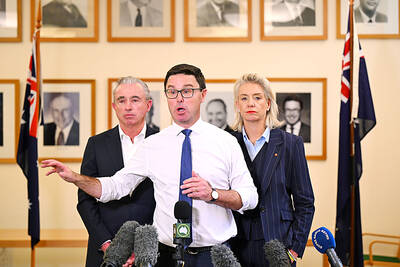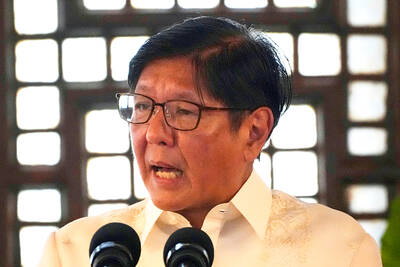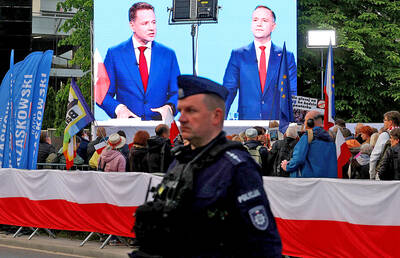Even a monarch needs a little help from time to time — especially when the cost of heating those drafty old palaces spirals past US$1.5 million a year.
However, a request for assistance from a government fund that provides subsidized heating to low-income Britons has caused a spot of bother for Queen Elizabeth II, long one of the world’s wealthiest women.
Her majesty’s application in 2004 was politely turned down by the government — in part because of fear of adverse publicity — and quietly forgotten until the Independent newspaper published the correspondence on Friday after obtaining it via a freedom of information request.
The documents quote an unidentified functionary as gently reminding the royal household that the program was meant for people in need, not the upper crust and he noted the potential public relations disaster.
“I also feel a bit uneasy about the probable adverse press coverage if the Palace were given a grant at the expense of, say, a hospital,” the official said. “Sorry this doesn’t sound more positive.”
Palace officials confirmed the account on Friday. A Buckingham Palace spokeswoman said royal officials explored the possibility of getting money under the program as a way to reduce the monarchy’s cost to taxpayers by making the palace more energy efficient.
She said the royal household did not know at the time that the government money was targeted for low-income Britons. She spoke anonymously in line with royal policy.
The revelation touched a nerve at a time when Britain is facing severe budget cuts in the midst of a prolonged recession.
Graham Smith, spokesman for the anti-monarchy group Republic, said the queen’s attempt to access low-income funds was shameful.
“It is clear evidence of the contempt the palace has for ordinary people in this country,” he said.
Some Londoners agreed.
Nick Bowring, a 23-year-old fitness instructor, said he didn’t think the queen should get help paying heating bills.
“There are people who need it a lot more than she does,” he said.
The queen’s finances have been controversial in the past, with occasional debates about whether Britain’s head of state — whose role is largely ceremonial — costs taxpayers too much.
The 84-year-old monarch has royal residences across Britain, including Balmoral Castle in Scotland and Sandringham House in eastern England. Other residences, such as the Palace of Holyroodhouse in Edinburgh and St James’ Palace in London, are used as offices or for functions.
She has many other assets, including an extensive art collection and a fleet of the world’s finest automobiles at her beck and call, although the royal yacht has been sold.
Buckingham Palace has been in royal hands since King George III bought it in 1761 and has been the official London residence of Britain’s monarchs since 1837. While it has magnificent gardens and grand state rooms with priceless paintings and furniture, large parts of the sprawling 775-room palace have not been modernized and are cold and drafty. Many of the rooms used by staff are downright dingy.
Insulation is poor and the heating system needs replacement, as do many of the windows, which lack proper glazing. Thermal imaging testing, used to identify and measure energy waste, showed heat escaping through palace windows, the roof and cracks in the walls.
Taxpayers fund the royal household to the tune of £38.2 million (US$60 million) a year, which the monarch’s official Web site points out costs Britain’s 62 million people less than £0.62 each.
It notes that royal spending has been cut substantially over the past two decades, dropping from £87.3 million in the 1991 to 1992 fiscal year to £38.2 million this year. That amount doesn’t include the cost of providing security for the queen and her family.
The queen also receives £7.9 million of public money each year to pay for staff and other costs, an amount that has not risen in 20 years.
The accounts show the government spent more than £15 million on the upkeep of royal residences including Buckingham Palace and Windsor Castle, and almost £4 million on royal travel.
While some criticized the queen for trying to get still more government help, others defended her.
Ian Laming, a 49-year-old carpenter, said the government should have approved her request.
“She helps a lot,” he said, adding that the monarch was a big boon to the UK economy. “You just have to walk down to Buckingham Palace to see all the tourists.”

BACKLASH: The National Party quit its decades-long partnership with the Liberal Party after their election loss to center-left Labor, which won a historic third term Australia’s National Party has split from its conservative coalition partner of more than 60 years, the Liberal Party, citing policy differences over renewable energy and after a resounding loss at a national election this month. “Its time to have a break,” Nationals leader David Littleproud told reporters yesterday. The split shows the pressure on Australia’s conservative parties after Prime Minister Anthony Albanese’s center-left Labor party won a historic second term in the May 3 election, powered by a voter backlash against US President Donald Trump’s policies. Under the long-standing partnership in state and federal politics, the Liberal and National coalition had shared power

NO EXCUSES: Marcos said his administration was acting on voters’ demands, but an academic said the move was emotionally motivated after a poor midterm showing Philippine President Ferdinand Marcos Jr yesterday sought the resignation of all his Cabinet secretaries, in a move seen as an attempt to reset the political agenda and assert his authority over the second half of his single six-year term. The order came after the president’s allies failed to win a majority of Senate seats contested in the 12 polls on Monday last week, leaving Marcos facing a divided political and legislative landscape that could thwart his attempts to have an ally succeed him in 2028. “He’s talking to the people, trying to salvage whatever political capital he has left. I think it’s

Polish presidential candidates offered different visions of Poland and its relations with Ukraine in a televised debate ahead of next week’s run-off, which remains on a knife-edge. During a head-to-head debate lasting two hours, centrist Warsaw Mayor Rafal Trzaskowski, from Polish Prime Minister Donald Tusk’s governing pro-European coalition, faced the Eurosceptic historian Karol Nawrocki, backed by the right-wing populist Law and Justice party (PiS). The two candidates, who qualified for the second round after coming in the top two places in the first vote on Sunday last week, clashed over Poland’s relations with Ukraine, EU policy and the track records of their

UNSCHEDULED VISIT: ‘It’s a very bulky new neighbor, but it will soon go away,’ said Johan Helberg of the 135m container ship that run aground near his house A man in Norway awoke early on Thursday to discover a huge container ship had run aground a stone’s throw from his fjord-side house — and he had slept through the commotion. For an as-yet unknown reason, the 135m NCL Salten sailed up onto shore just meters from Johan Helberg’s house in a fjord near Trondheim in central Norway. Helberg only discovered the unexpected visitor when a panicked neighbor who had rung his doorbell repeatedly to no avail gave up and called him on the phone. “The doorbell rang at a time of day when I don’t like to open,” Helberg told television